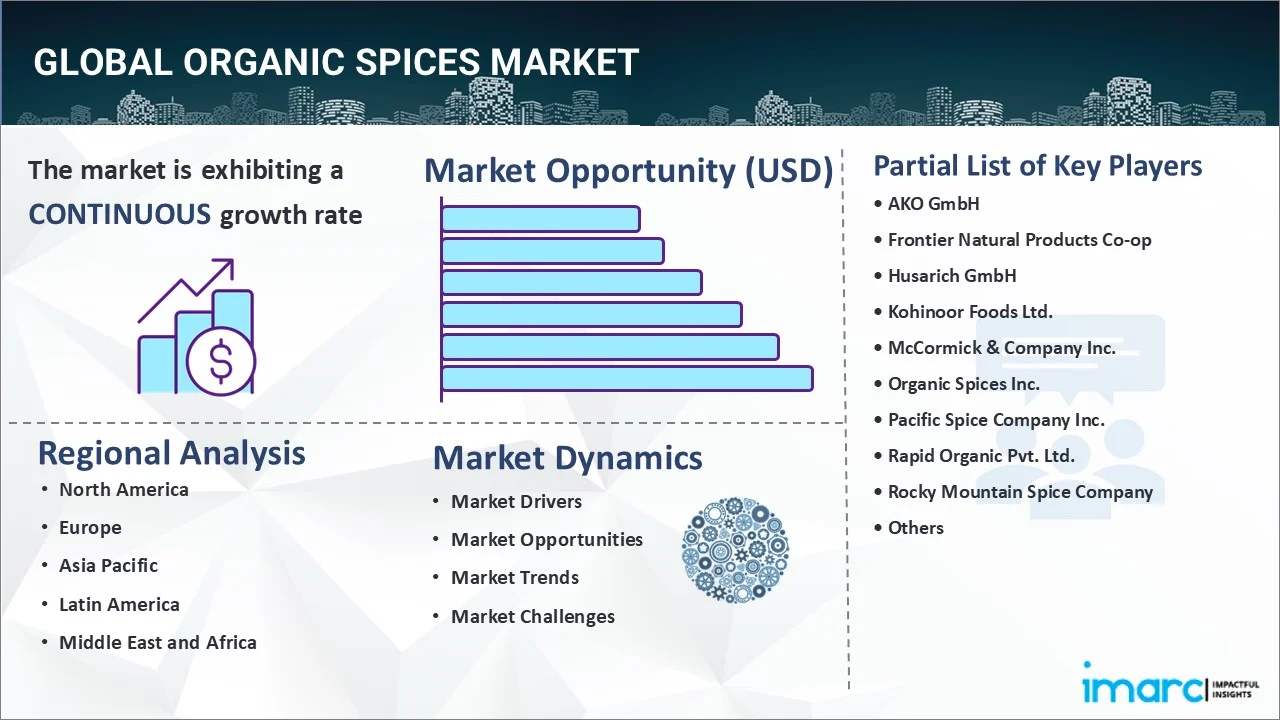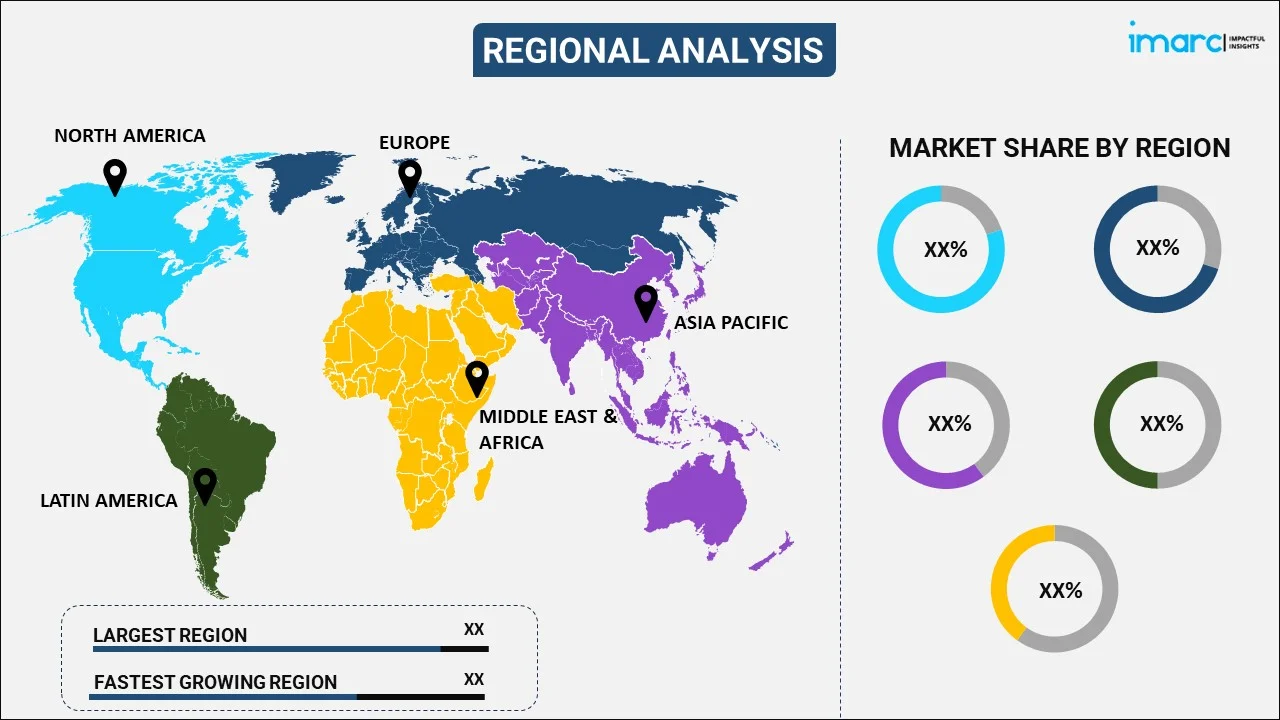
Organic Spices Market Report by Product Type (Turmeric, Ginger, Clove, Pepper, Cinnamon, Nutmeg, Mustard Seeds, and Others), Form (Powder, Whole, Chopped/Crushed), Application (Commercial, Household), Distribution Channel (Supermarkets/Hypermarkets, Convenience Stores, Online Stores), and Region 2025-2033
Market Overview:
The global organic spices market size reached USD 29.2 Billion in 2024. Looking forward, IMARC Group expects the market to reach USD 49.1 Billion by 2033, exhibiting a growth rate (CAGR) of 6% during 2025-2033. The heightened health awareness among the masses, growing emphasis on ethical consumption, escalating food safety concerns, imposition of various government policies and regulations, growing expenditure capacities and adoption of eco-friendly packaging are some of the major factors propelling the market.
|
Report Attribute
|
Key Statistics
|
|---|---|
|
Base Year
|
2024
|
|
Forecast Years
|
2025-2033
|
|
Historical Years
|
2019-2024
|
|
Market Size in 2024
|
USD 29.2 Billion |
|
Market Forecast in 2033
|
USD 49.1 Billion |
| Market Growth Rate 2025-2033 | 6% |
Organic spices refer to seasonings produced without the use of synthetic fertilizers, pesticides, or genetically modified organisms. It includes organic black pepper, turmeric, cinnamon, ginger, clove, nutmeg, mustard seeds, and cayenne pepper. They are widely used in cooking, baking, medicinal purposes, skin care products, natural food preservatives, aromatherapy, and insect repellents. Organic spices are highly nutritious, versatile, and safe products that provide long shelf life, enhanced flavor profile, and anti-inflammatory properties. In addition, they lower the risk of pesticide residue contamination, promote sustainability, and increase farmer’s income.

The imposition of various government policies and regulations encouraging farmers to switch to organic farming methods through incentives and subsidies is propelling the market growth. Furthermore, the increasing consumer willingness to pay a premium for organic products, owing to the growing expenditure capacities, is contributing to the market growth. Additionally, the emerging trends of global and fusion cuisines, which require a diverse range of spices, are acting as another growth-inducing factor. Besides this, the adoption of eco-friendly packaging for organic spices to attract environmentally conscious consumers is positively influencing the market growth. Apart from this, the expansion of retail channels, including offline and online platforms, which enhance consumer convenience and provide access to a wide range of organic spice varieties, is strengthening the market growth. Moreover, the recent technological advancements in logistics and storage, which facilitate better shelf-life and wider distribution of organic spices, are fueling the market growth.
Organic Spices Market Trends/Drivers:
The heightened health awareness among the masses
The increasing understanding of the health implications associated with food choices is significantly influencing the organic spices market. Consumers are becoming more aware of the various constituents of organic spices, such as essential nutrients, antioxidants, and phytochemicals. In addition, the emerging fitness culture and preventive healthcare regimes are facilitating the demand for organic spices in various healthy diets. Furthermore, this demand is bolstered by a plethora of scientific studies that detail the potential risks of synthetic pesticides and fertilizers in traditional agriculture. Moreover, these chemicals can lead to a range of health issues, including allergies, digestive problems, or severe long-term consequences such as cancer. As a result, individuals are turning towards organic spices as a safe and healthier alternative.
The growing emphasis on ethical consumption
The growing emphasis on sustainability, which is influencing purchasing decisions based on ethical considerations, is driving the market growth. In line with this, organic farming practices are seen as more sustainable and socially responsible owing to their reduced impact on the environment and support for local communities. Furthermore, organic agriculture often utilizes crop rotations, green manures, and other techniques that nourish the soil rather than deplete it, thus contributing to long-term agricultural sustainability. This farming method also avoids synthetic chemicals, which aids in improving local ecosystems and biodiversity. Moreover, organic farming is less harmful to farmers, as it eliminates the exposure to synthetic pesticides and fertilizers. These factors combine to make organic spices an increasingly popular choice among ethically conscious consumers.
The escalating food safety concerns
The growing emphasis on food safety, owing to the rising number of food-related illnesses, coupled with an increased understanding of the long-term impacts of synthetic additives, is propelling the market growth. Organic spices aid in mitigating these concerns by avoiding the utilization of synthetic pesticides and fertilizers in their production processes, thereby reducing the risk of chemical residues in the end product. Furthermore, consumers are becoming more educated about these risks and are choosing organic spices as a safer option. In addition, organic spices come with certification labels that indicate their organic status. This transparency enables consumers to make informed choices about the products they purchase, knowing that they have met specific organic standards.
Organic Spices Industry Segmentation:
IMARC Group provides an analysis of the key trends in each segment of the global organic spices market report, along with forecasts at the global, regional and country levels from 2025-2033. Our report has categorized the market based on product type, form, application and distribution channel.
Breakup by Product Type:

- Turmeric
- Ginger
- Clove
- Pepper
- Cinnamon
- Nutmeg
- Mustard Seeds
- Others
Turmeric dominates the market
The report has provided a detailed breakup and analysis of the market based on product type. This includes turmeric, ginger, clove, pepper, cinnamon, nutmeg, mustard seeds, and others. According to the report, turmeric represented the largest segment.
Turmeric is dominating the market as it is widely used in natural treatment for conditions, such as arthritis, digestive issues, and skin problems. Furthermore, it finds versatile applications in various cuisines around the world, making it universally appealing. Furthermore, turmeric holds a significant place in traditional medicine and rituals, adding a cultural value to its consumption. Apart from this, numerous scientific studies that validate the health benefits of turmeric leading to increased consumer trust, are acting as another growth-inducing factor. Moreover, the widespread product utilization in skincare products, such as lotions, creams, and face wash, is positively influencing the market growth. Besides this, turmeric is relatively easy to grow organically, making it a sustainable choice for farmers.
Breakup by Form:
- Powder
- Whole
- Chopped/Crushed
Powder holds the largest share in the market
A detailed breakup and analysis of the market based on the form has also been provided in the report. This includes powder, whole, and chopped/crushed. According to the report, powder represented the largest segment.
Powdered organic spices are dominating the market as they are easy to measure, mix, and incorporate into dishes. Additionally, grinding spices into a powder increases the surface area exposed to air and moisture, which enhances the release of flavors and aromas when added to dishes. Furthermore, powdered spices are distributed more evenly throughout a dish compared to whole or coarsely ground spices. Moreover, powered organic spices evenly be distributed ensuring that the flavor is spread consistently, enhancing the overall taste of the dish. In line with this, powdered spices are much easier to blend and mix, ensuring that the final flavor profile is balanced and consistent.
Breakup by Application:
- Commercial
- Household
Commercial holds the largest share in the market
A detailed breakup and analysis of the market based on application has also been provided in the report. This includes commercial and household. According to the report, commercial accounted for the largest market share.
The commercial sector is dominating the market, as it requires a consistent and reliable supply of organic spices to meet the growing consumer demand for organic and natural food products. In line with this, restaurants, food manufacturers, and other food service businesses often use organic spices to cater to health-conscious and environmentally aware-consumers. Furthermore, organic spices are commonly used in the production of processed and packaged foods, as they require standardized flavor profiles and consistent quality. Moreover, the culinary industry is placing greater emphasis on using high-quality, natural, and organic ingredients to enhance the flavor and health value of dishes.
Breakup by Distribution Channel:
- Supermarkets/Hypermarkets
- Convenience Stores
- Online Stores
Supermarkets/hypermarkets hold the largest share in the market
A detailed breakup and analysis of the market based on distribution channel has also been provided in the report. This includes supermarkets/hypermarkets, convenience stores, and online stores. According to the report, supermarket/hypermarkets accounted for the largest market share.
Supermarkets/hypermarkets provide a one-stop shopping experience where consumers can find a diverse variety of products, including organic spices, in a single location. Furthermore, these large retail outlets have the space and resources to stock a diverse range of products, including organic spices. This availability makes it easier for consumers to find the specific spices they're looking for without having to visit multiple specialty stores. Additionally, supermarkets/hypermarkets have substantial marketing budgets that they can allocate to promoting organic products, including spices. Besides this, they offer competitive pricing due to their purchasing power and economies of scale, which makes organic spices more accessible to a broader range of consumers.
Breakup by Region:

- North America
- United States
- Canada
- Asia-Pacific
- China
- Japan
- India
- South Korea
- Australia
- Indonesia
- Others
- Europe
- Germany
- France
- United Kingdom
- Italy
- Spain
- Russia
- Others
- Latin America
- Brazil
- Mexico
- Others
- Middle East and Africa
Asia Pacific exhibits a clear dominance, accounting for the largest organic spices market share
The market research report has also provided a comprehensive analysis of all the major regional markets, which include North America (the United States and Canada); Asia Pacific (China, Japan, India, South Korea, Australia, Indonesia, and others); Europe (Germany, France, the United Kingdom, Italy, Spain, Russia, and others); Latin America (Brazil, Mexico, and others); and the Middle East and Africa. According to the report, Asia Pacific accounted for the largest market share.
Asia Pacific has a rich culinary history that heavily relies on the use of spices in various traditional dishes. Furthermore, the region is known for its rich biodiversity, which includes a wide variety of plants and herbs that are used as spices. Additionally, the widespread prevalence of traditional and organic farming practices puts the Asia Pacific region in a favorable position to transition into the organic spices market. Besides this, the growing demand for organics and natural ingredients due to heightened health consciousness among the masses is fueling the market growth. Moreover, the imposition of various policies and incentives by regional governments to encourage organic farming and promote exports of organic products is contributing to the market growth.
Competitive Landscape:
Leading companies are establishing transparent and reliable supply chains for organic spices by collaborating with organic farmers, cooperatives, and suppliers. Furthermore, they are focusing on obtaining and maintaining relevant certifications to build consumer trust by demonstrating adherence to strict organic farming practices and quality standards. Additionally, several market players are offering a wide range of organic spice varieties and blends to cater to diverse culinary preferences. They are also exploring innovative packaging, such as resealable bags or sustainable packaging materials, to enhance product freshness and appeal. Besides this, major producers are investing in educational campaigns to raise awareness about the differences between organic and conventional spices, as well as the impact of their choices on personal health and the environment.
The report has provided a comprehensive analysis of the competitive landscape in the market. Detailed profiles of all major companies have also been provided. Some of the key players in the market include:
- AKO GmbH
- Frontier Natural Products Co-op
- Husarich GmbH
- Kohinoor Foods Ltd.
- McCormick & Company Inc.
- Organic Spices Inc.
- Pacific Spice Company Inc.
- Rapid Organic Pvt. Ltd.
- Rocky Mountain Spice Company
- Spice Chain Corporation
- Starwest Botanicals
- Watkins Incorporated
Recent Developments:
- In February 2023, Frontier Natural Products Co-op unveiled a new sustainable bulk packaging for its spices, herbs, and botanicals.
- In March 2023, McCormick & Company Inc. launched a brand-new packing design for its core line of herbs and spices.
- In May 2023, Organic Spices Inc. announced that it has expanded into contract manufacturing and private label co-packing to bring values to customers.
Organic Spices Market Report Scope:
| Report Features | Details |
|---|---|
| Base Year of the Analysis | 2024 |
| Historical Period | 2019-2024 |
| Forecast Period | 2025-2033 |
| Units | Billion USD |
| Scope of the Report | Exploration of Historical Trends and Market Outlook, Industry Catalysts and Challenges, Segment-Wise Historical and Predictive Market Assessment:
|
| Product Types Covered | Turmeric, Ginger, Clove, Pepper, Cinnamon, Nutmeg, Mustard Seeds, Others |
| Forms Covered | Powder, Whole, Chopped/Crushed |
| Applications Covered | Commercial, Household |
| Distribution Channels Covered | Supermarkets/Hypermarkets, Convenience Stores, Online Stores |
| Regions Covered | Asia Pacific, Europe, North America, Latin America, Middle East and Africa |
| Countries Covered | United States, Canada, Germany, France, United Kingdom, Italy, Spain, Russia, China, Japan, India, South Korea, Australia, Indonesia, Brazil, Mexico |
| Companies Covered | AKO GmbH, Frontier Natural Products Co-op, Husarich GmbH, Kohinoor Foods Ltd., McCormick & Company Inc., Organic Spices Inc., Pacific Spice Company Inc., Rapid Organic Pvt. Ltd., Rocky Mountain Spice Company, Spice Chain Corporation, Starwest Botanicals, Watkins Incorporated, etc. |
| Customization Scope | 10% Free Customization |
| Post-Sale Analyst Support | 10-12 Weeks |
| Delivery Format | PDF and Excel through Email (We can also provide the editable version of the report in PPT/Word format on special request) |
Key Benefits for Stakeholders:
- IMARC’s industry report offers a comprehensive quantitative analysis of various market segments, historical and current market trends, market forecasts, and dynamics of the organic spices market from 2019-2033.
- The research report provides the latest information on the market drivers, challenges, and opportunities in the global organic spices market.
- The study maps the leading, as well as the fastest-growing, regional markets. It further enables stakeholders to identify the key country-level markets within each region.
- Porter's five forces analysis assist stakeholders in assessing the impact of new entrants, competitive rivalry, supplier power, buyer power, and the threat of substitution. It helps stakeholders to analyze the level of competition within the organic spices industry and its attractiveness.
- Competitive landscape allows stakeholders to understand their competitive environment and provides an insight into the current positions of key players in the market.
Key Questions Answered in This Report
The global organic spices market was valued at USD 29.2 Billion in 2024.
We expect the global organic spices market to exhibit a CAGR of 6% during 2025-2033.
The sudden outbreak of the COVID-19 pandemic has led to the changing consumer inclination from conventional brick-and-mortar distribution channels towards online retail platforms for the purchase of organic spices.
The rising consumer awareness towards numerous therapeutic benefits of organic spices, such as boosting immunity, reducing the risk of cancer, improving gastric ailments, etc., is primarily driving the global organic spices market.
Based on the product type, the global organic spices market has been segmented into turmeric, ginger, clove, pepper, cinnamon, nutmeg, mustard seeds, and others. Currently, turmeric holds the majority of the total market share.
Based on the form, the global organic spices market can be divided into powder, whole, and chopped/crushed. Among these, powder exhibits a clear dominance in the market.
Based on the application, the global organic spices market has been segregated into commercial and household, where the commercial sector currently accounts for the largest market share.
Based on the distribution channel, the global organic spices market can be bifurcated into supermarkets/hypermarkets, convenience stores, and online stores. Currently, supermarkets/hypermarkets exhibit a clear dominance in the market.
On a regional level, the market has been classified into North America, Asia-Pacific, Europe, Latin America, and Middle East and Africa, where Asia-Pacific currently dominates the global market.
Some of the major players in the global organic spices market include AKO GmbH, Frontier Natural Products Co-op, Husarich GmbH, Kohinoor Foods Ltd., McCormick & Company Inc., Organic Spices Inc., Pacific Spice Company Inc., Rapid Organic Pvt. Ltd., Rocky Mountain Spice Company, Spice Chain Corporation, Starwest Botanicals, and Watkins Incorporated.
Need more help?
- Speak to our experienced analysts for insights on the current market scenarios.
- Include additional segments and countries to customize the report as per your requirement.
- Gain an unparalleled competitive advantage in your domain by understanding how to utilize the report and positively impacting your operations and revenue.
- For further assistance, please connect with our analysts.
 Inquire Before Buying
Inquire Before Buying
 Speak to an Analyst
Speak to an Analyst
 Request Brochure
Request Brochure
 Request Customization
Request Customization




.webp)




.webp)












